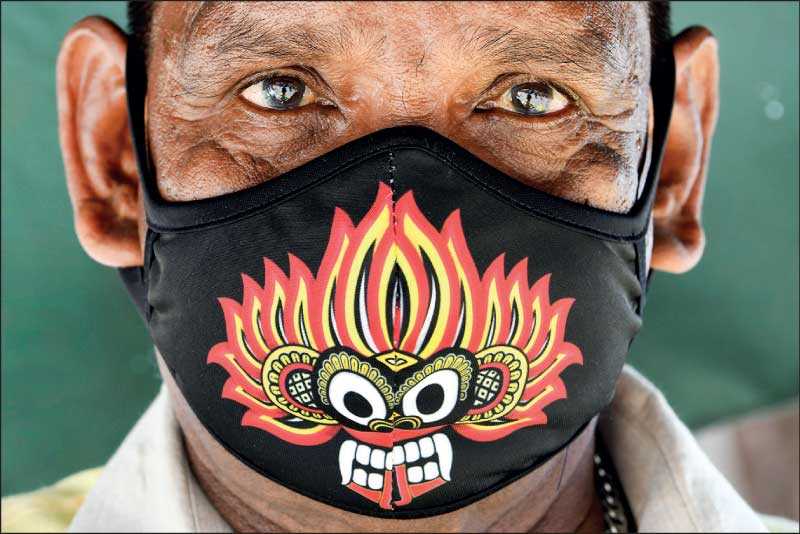Wednesday Jan 07, 2026
Wednesday Jan 07, 2026
Monday, 9 November 2020 00:30 - - {{hitsCtrl.values.hits}}

Sri Lanka is by and large, even with the surge, and a few anomalies above, hale and hearty, well looked after by medical professionals, and has no grounds to fear being medically overwhelmed or over-run by COVID – Pic by Shehan Gunasekara
 Before we get to the two prescriptions, a little local update. I am getting increasingly troubled by the classification of “COVID deaths” in Lanka. There seems to have been a surge of them, and on the surface, that is not surprising when 6,000 or more “positive test results” (posing as “cases”) have been introduced in about a month’s time. And given that, a mortality rise from 13 to 30, “seems” very mild or modest.
Before we get to the two prescriptions, a little local update. I am getting increasingly troubled by the classification of “COVID deaths” in Lanka. There seems to have been a surge of them, and on the surface, that is not surprising when 6,000 or more “positive test results” (posing as “cases”) have been introduced in about a month’s time. And given that, a mortality rise from 13 to 30, “seems” very mild or modest.
A .14% infection fatality rate which is a global forecast would give us 840 deaths for 6,000 actual infections. Global tallies suggest many more are “infected” than we know, asymptomatic and shrug it off, and there, the forecasts are .03%. In that case, we would have had 180 deaths or be en route to them. It is clear we are nowhere near that trajectory, and so my quibbling for classification provoked by 21 deaths seems a bit extreme. But there are reasons of clarity for doing so, to demonstrate just how relatively “safe” we’ve been despite frenzy and over-reaction.
Globally, the probability of dying if infected by the virus for 10-19 years old is .2%, 20-29 years old is .2%, 30-39 years old is still .2%, 40-49 years old is .4%, it only edges up to 1.3% in the 50-59 year age group, then 3.6% when 60-69. These are from cases. Looking at actual CDC data in the US, for end of October, 15-24-year old’s represented .18% of the deaths, 25-34 year old’s represented only .77% of the deaths and the numbers really only climbed above 65. This holds true overwhelmingly, globally, and has done since the pandemic began. Hence when results are inconsistent with that, we have to be careful.
Take Singapore with over 50,000 cases, only 28 deaths. Hence you can see how carefully they classify outright “from” COVID deaths, rather than cases where say from a post-mortem there was a positive C-19 test, or where it was at most a complicating factor of unknown impact.
Lanka COVID deaths (a respectful analysis)
I detail all of these to highlight that clear C-19 deaths even out of the 34 can be a struggle, particularly given what we know of the overwhelming vulnerability profile ages, and the confusion of asserting COVID as a “cause” of death primarily from a positive test result, or even from the presence of an infection when there are comorbidities.
All this to say, Lanka is by and large, even with the surge, and a few anomalies above, hale and hearty, well looked after by medical professionals, and has no grounds to fear being medically overwhelmed or over-run by COVID.
Prescriptions
There are really only two approaches to managing COVID going forward. It seems the President here has expressed his support for prescription one. We have to salute and support that.
This is being increasingly taken up, as a necessity, globally and regionally. And so let us take our available approaches to COVID and recast them as “prescriptions”, courses of action, with varying likelihood of success, collateral damage, sustainability, and “side effects.”
Prescription one
Let life go on, protect the most vulnerable, practice some prudent distancing and heightened attention to hygiene, limit large “superspreader” environments for some time. Let our immune system and ability to medically treat this, both evolve.
The basis for it:
So, let us call that the basis for prescription number one. It has the benefit of being scientifically, sociologically and philosophically sound.
There is a possibility the prescription is over optimistic, and on that basis, one might argue that we need more than personal initiative, we need state supervised lockdown light to some degree that still lets life and business and society function, along with a degree of enforced mask mandates among other such intrusions into our normal lives.
Now this begs the question that, other than islands that have utterly isolated themselves from the rest of the planet, there is no statistical demonstration that COVID results have been positively affected by the severity or extent of a lockdown.
Some of the best results have been found in either countries where there was never a lockdown or where it was targeted, episodic and relatively mild (no curfews, no extended shutdown of human interaction or related industries or businesses). These countries include: Japan, Taiwan, Hong Kong, Singapore, South Korea, Vietnam, Cambodia, Belarus, Sweden, Norway, Switzerland and some key US states.
Then the question has to be asked of this potential challenge to Prescription 1: What really is the theory of lockdown, a penal concept that, since the middle ages, has not been on any public health recommendation until this year when the world decided to play “Simon Says” with Wuhan after their having after-the-fact bolted the barn door so to speak?
Since viruses are best tackled in the outdoors with natural vitamin D sunlight, then why the alternative to this prescription would be to lock up the sick with the well for long periods of time, thinking this would be a ‘cure’ is baffling. And if we somehow manage to interrupt the chain of transmission by so doing, why do we think this will not just keep recurring every season as our immune systems will not have made their peace with this pathogen? This way we are only deferring the inevitable reckoning.
Since we understand that a vaccine, based on the experience of the last decade, is largely effective at best in 50% of the cases and largely ineffective for those above 75 (the precise target group that this virus is most lethal for) and knowing that a realistically tested, universally available vaccine is years away, surely the counter-suggestion to this prescription is not that we keep the world in suspended animation for a virus which has the fatality of a medium influenza season, while we await something which will not be a solution at all. It may be a helpful weapon in the arsenal, but no more.
And given the fact that much of the world is blessed with virus destroying sunshine, and these sun-kissed parts of the world by and large have far lower mortality rates on even the official COVID numbers, what would justify our ignoring the vast disparity in the percentage of deaths in Asia and Africa compared with other parts of the world, augmented doubtless by their immunological robustness thanks to having grappled with less than hygienic living conditions and legions of other pathogens?
So the only real argument against Prescription Number 1 seems rationally that despite these rebuttals and reasons to doubt that critique, we might need to make the restrictions tighter, harsher or longer. It seems at best an uncertain case, but that is the most that could be said.
Prescription two
This is the prevailing orthodoxy. It is basically shut down the virus by shutting down life as we know it.
So, we shut down travel, trade, large sectors of the economy, exercise what amounts to a forced seizure of property by ordering businesses closed, depriving families and friends the ability to interact and support each other, potentially irrecoverably damage educational and personal development for children at some of the most formative stages of their lives, make it impractical or impossible for people to get necessary medical tests, procedures, vaccinations, medicine and more. This latter by itself leads to a tsunami of other-cause mortality, certainly a truly exponential rise in illnesses that were earlier being routed like malaria, HIV and TB.
There is then the imposition of poverty across regions in staggering numbers and populations with literal malnutrition skyrocketing, including for children, terrifying debt levels and a simple question which cannot be answered and even dare not be whispered it seems, in short, what the hell are we going to do the next time a pathogen comes calling if this is all we can come up with, namely civilisational suicide?
Now unlike the critique of Prescription 1 which is a matter of how tight or how loose or how targeted various measures need to be, if we persist with Prescription 2, which is a neutron bomb equivalent, of this new public health ‘crack’ we seem to have defaulted to, all of the carnage described here is not theoretical, it’s already happening. And if we shut down the world for an extended period, it is inevitable. The cataclysm we are causing will redefine “pyrrhic victory,” even if one day COVID does what it almost certainly will, become another part of our epidemiology.
Can we even compare them?
So, let’s compare the two prescriptions.
When doctors write prescriptions, they let you know likely side effects.
The likely side effect of Prescription Number 1 is that we are underestimating the virulence of this virus and will need to apply data-driven successive circuit breakers beyond personal initiative, though this demands that we have something more than the spurious testing regime that currently prevails. We need to know the situation to deal with it. And this would need to be mortality driven, not positive test driven as the vast majority of those who contract C-19 are asymptomatic and not at risk. But this is the worst that can happen from Prescription 1, an adaptation and adjustment which we‘ve done for disease after disease throughout our history and indeed for other challenges such as terrorism and natural disasters. In fact, we are here as a species and a society because that playbook works.
Prescription 2 leads to the large-scale potential destruction of our planetary viability, retarding progress, decimating economies and livelihoods rather than learning to sanely and sagely grapple with what is essentially a novel version of pneumonia.
So, that set of impacts following that prescription are guaranteed, it is not hypothetical, as we’ve said.
As I wrote in an earlier article and it bears repeating: “Vaccinations deferred, businesses wiped out, economic sectors collapsing, mental illness spiked, irrecoverable impact on children’s education, usurping of civil liberties, destroying social bonds, actions so extreme they have never been undertaken for any war, natural disaster, epidemic, pandemic, act of terrorism in anything akin to this sustained, ruinous, manner…to attempt to quell the “positive test results” (which we can’t even bother to standardise or quality control around the world before paralysing life as we know it for), for a disease survived by over 99% of those under 70 who contract it. According to the CDC, even above 70, lethality is .054.”
For the love of all that is decent, all that is sane, all that is humane can anyone tell us how this can possibly even be a choice? Might we agree to take the only sane medicine here? High time, in fact long overdue, necessary and needed, now.
